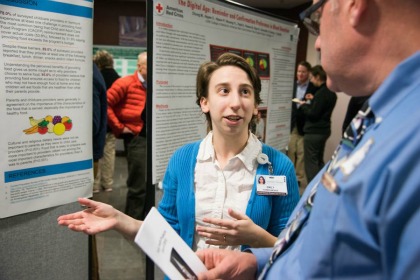Attitudes and tobacco use before and after the launch of the University of Vermont's tobacco-free campus policy and barriers to providing opioid dependence treatment in primary care offices were topics for two of 16 University of Vermont College of Medicine Public Health Projects conducted by medical students in the Class of 2018 during the fall 2015 semester.

Emily Forbes-Mobus ‘18, describes her team's Public Health Project on "Nutrition in Early Childcare Programs" to Michael Upton, M.D., at the 2016 Public Health Projects Poster Session & Community Celebration (Photo: Andy Duback)
Attitudes and tobacco use before and after the launch of the University of Vermont's tobacco-free campus policy and barriers to providing opioid dependence treatment in primary care offices were topics for two of 16 University of Vermont College of Medicine Public Health Projects conducted by medical students in the Class of 2018 during the fall 2015 semester. Results from these studies, along with 14 other projects, were displayed at the annual Public Health Poster Session & Community Celebration on January 20, 2016 in the Hoehl Gallery in the College's Health Science Research Facility. View the event photo gallery.
Immediately following the event, the Health Equity Lecture, featuring Camara Jones, M.D., M.P.H., Ph.D., president-elect of the American Public Health Association, took place in the Sullivan Classroom in the Medical Education Center. Jones, along with Jan Carney, M.D., M.P.H., associate dean for public health and course director of the Public Health Projects, UVM College of Medicine Dean Frederick Morin, M.D., and United Way of Chittenden County (UWCC) Coordinator of Volunteer Mobilization Laurie Dana presented remarks at the event.
With help from UWCC, student project topics stem from health needs identified by local community agencies. Students use practical research methods and work with faculty and community agencies to find creative ways to put science into practice. The results of their work often drive changes within these agencies, sometimes inform health-related bills under consideration in the legislature, and earn attention from the American Public Health Association, which accepts several student projects for presentation at its national meeting each year.
"This year's projects cover an incredible range of public health issues and innovative approaches to improving them," says Jan Carney, M.D., M.P.H., associate dean for public health and course director of the Public Health Projects at the UVM College of Medicine.
Some of the projects featured at the event included:
Electronic Screening Tool for Human Trafficking
Human trafficking - a form of modern-day slavery - occurs worldwide, even in Vermont. While clinicians are in a unique position to recognize patient in these circumstances, there is currently no widely used protocol in the healthcare setting to screen patients. In this project, titled "Slipping Through the Cracks: Receptivity of Healthcare Professionals to an Electronic Screening Tool for Human Trafficking," the goal was to assess healthcare worker receptivity to the implementation of an electronic screening tool with the capacity to eliminate language barriers and to standardize the process of identifying trafficking victims. They surveyed 26 Vermont healthcare practitioners [15 primary care physicians, 4 emergency department physicians, 3 nurses, 3 emergency medical technicians, and 1 physician assistant] to gauge their opinions on the usability of an electronic screening tool based on an established method of risk-based screening for human trafficking. More than 50 percent of participants reported that the issue of human trafficking was not
addressed in their professional training, and only four percent reported having a formal protocol in place. A total of 92 percent of respondents reported that this type of electronic screening tool or something similar would be useful in a healthcare setting and would help them to identify trafficking victims. The students also found that certain barriers to implementation existed, including time constraints in a clinical setting.
UVM Tobacco-Free Policy
On August 1, 2015, UVM joined more than 1,600 other U.S. colleges in adopting a tobacco-free policy. Students working on the "UVM Tobacco Use and Attitudes After Implementation of a Tobacco-Free Policy" project aimed to compare tobacco use and attitudes before and after policy implementation. The group administered an electronic survey to 19,605 UVM students, faculty and staff and learned that the implementation of the new policy resulted in a reported significant decrease in secondhand smoke exposure and a statistically significant reduction in tobacco use among undergraduates.
Barriers to Primary Care Office-Based Opiate Treatment
With the number of Vermonters seeking treatment for opioid abuse increasing, ensuring greater availability of treatment via outpatient office-based opioid treatment (OBOT) providers is needed. For their project, titled "Addressing the Opioid Crisis in Vermont: Lessons Learned from Primary Care Physicians," students interviewed 25 primary care physicians in Chittenden County, Vt., 11 of whom provided OBOT, regarding the barriers to providing OBOT. The Class of 2018 medical students working on this project found that "the five most frequently reported barriers were: insufficient state logistical support, challenging patient population, practice infrastructure/capacity, time, and provider fears/concerns. Seventy-nine percent of non-prescriber PCPs said that they would provide OBOT if the identified barriers were removed."
Learn more about the UVM College of Medicine Public Health Projects course.